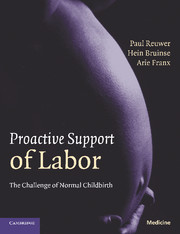Book contents
- Frontmatter
- Contents
- Foreword
- Acknowledgments
- Web-Forum
- 1 General introduction
- Section 1 A wake-up call
- Section 2 Back to basics
- Section 3 Proactive support of labor
- 12 Introductory synopsis
- 13 Nulliparous versus parous labor
- 14 Diagnosis of labor
- 15 Prevention of long labor
- 16 Personal continuity and continuous support
- 17 Amniotomy and oxytocin
- 18 Labor pain in broader perspective
- 19 Prelabor preparation
- 20 Medical pain relief revisited
- 21 Dynamic dystocia unraveled
- 22 Mechanical birth obstruction
- 23 Curtailed use of induction
- 24 Intrapartum care of the fetus
- 25 Prevention of litigation
- 26 Organizational reforms
- 27 Continual audit and feedback
- 28 Quality assessment
- 29 Hospital statistics
- 30 Sum of the parts
- Index
- References
29 - Hospital statistics
Published online by Cambridge University Press: 08 September 2009
- Frontmatter
- Contents
- Foreword
- Acknowledgments
- Web-Forum
- 1 General introduction
- Section 1 A wake-up call
- Section 2 Back to basics
- Section 3 Proactive support of labor
- 12 Introductory synopsis
- 13 Nulliparous versus parous labor
- 14 Diagnosis of labor
- 15 Prevention of long labor
- 16 Personal continuity and continuous support
- 17 Amniotomy and oxytocin
- 18 Labor pain in broader perspective
- 19 Prelabor preparation
- 20 Medical pain relief revisited
- 21 Dynamic dystocia unraveled
- 22 Mechanical birth obstruction
- 23 Curtailed use of induction
- 24 Intrapartum care of the fetus
- 25 Prevention of litigation
- 26 Organizational reforms
- 27 Continual audit and feedback
- 28 Quality assessment
- 29 Hospital statistics
- 30 Sum of the parts
- Index
- References
Summary
Although quality assessment of an obstetric service involves much more than just reporting operative delivery and perinatal mortality rates (Chapter 28), all care providers within one institution should know the institutional intervention and outcome data. An effective initiative to rekindle professionals’ desire to have a good spontaneous delivery rate is provision of each obstetrician with his/her individual operative delivery rates on a regular basis. But in comparisons the populations must be comparable. Some obstetricians will complain that their intervention rates are relatively high because of their “skewed population” with a higher proportion of multiple gestations, breech presentations, and patients with complicated diabetes, early-onset preeclampsia, HIV, etc. These conditions will have to be verified and taken into account when comparing overall intervention rates between doctors.
Problems and pitfalls in inter-hospital comparisons
Unfortunately, there still is a lack of standardized information allowing meaningful comparisons of hospital annual reports. Operative delivery rates may be affected by several demographic, obstetric, and fetal factors, as well as childbirth-system related issues – such as whether hospitals cover the entire regional pregnant population or only a part because of out-of-hospital deliveries attended by independent midwives. These factors are beyond the control of obstetricians and for this reason the “raw” cesarean birth rate of a hospital is unsuitable for assessing the labor and delivery skills of its birth professionals. To complicate matters further, hospital year reports vary widely in patient stratification.
- Type
- Chapter
- Information
- Proactive Support of LaborThe Challenge of Normal Childbirth, pp. 248 - 252Publisher: Cambridge University PressPrint publication year: 2009



